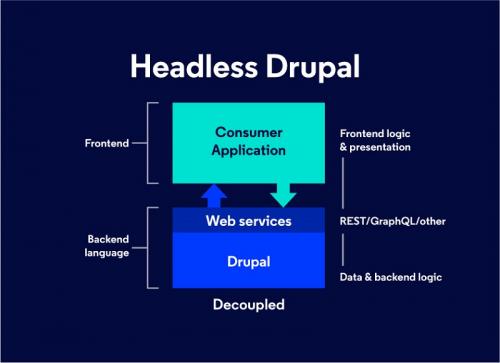Unleashing the Power of Headless Drupal Services: Transforming Content Delivery

As businesses strive to engage audiences
across web, mobile, and emerging digital channels, the traditional content
management systems (CMS) sometimes fall short in providing the necessary
flexibility and agility. This is where Headless Drupal comes into play,
revolutionizing the way content is managed, structured, and delivered.
Headless Drupal is
not your typical CMS. It's an API-first content management system that
decouples the backend content repository (Drupal) from the frontend
presentation layer. This decoupling allows for unparalleled flexibility and
scalability in content delivery, making it an ideal solution for businesses
looking to adapt to evolving customer demands and technological advancements.
Understanding
Headless Drupal
At its core, Drupal
is renowned for its robust content management capabilities, flexibility, and
extensibility. However, traditional Drupal implementations often tie the
content management backend tightly to the presentation layer, limiting the
agility with which content can be delivered across various platforms and
devices.
Headless Drupal
breaks free from these constraints by separating the content management backend
from the frontend presentation layer. In a headless architecture, Drupal serves
as a content repository accessible via APIs, while the frontend—whether it be a
web application, mobile app, or IoT device—consumes this content through API
calls.
Benefits of
Headless Drupal Services
1. Enhanced
Flexibility and Scalability
With Headless
Drupal, organizations gain unparalleled flexibility in content delivery.
Marketers and content creators can design and deliver content without being
constrained by the limitations of a monolithic CMS. Whether it's creating
personalized experiences for different audience segments or optimizing content
for specific devices, Headless Drupal enables businesses to adapt quickly to
changing market demands.
2. Improved
Time-to-Market
By decoupling the
backend content management from the frontend presentation layer, Headless
Drupal accelerates time-to-market for new digital experiences. Developers can
work independently on the frontend and backend components, allowing for
parallel development cycles and rapid iterations. This agility is especially
valuable in today's competitive landscape, where the ability to launch new
features and content quickly can be a significant differentiator.
3. Seamless
Omnichannel Experiences
In an increasingly
omnichannel world, delivering consistent and seamless experiences across all
touchpoints is crucial for success. Headless Drupal empowers businesses to
create and manage content centrally while delivering it across various channels
and devices. Whether it's a website, mobile app, smartwatch, or voice-activated
device, Headless Drupal ensures a consistent brand experience across all
platforms.
4. Future-Proof
Architecture
With Headless
Drupal, businesses can future-proof their digital infrastructure by embracing
emerging technologies and channels. As new devices and platforms continue to
emerge, Headless Drupal's API-first approach ensures compatibility and
interoperability, allowing organizations to adapt and innovate without being
tied to a specific technology stack.
Implementing
Headless Drupal: Best Practices
While the benefits
of Headless Drupal are compelling, successful implementation requires careful
planning and execution. Here are some best practices to consider:
1. Define Clear
Objectives and Use Cases
Before embarking on
a Headless Drupal implementation, clearly define your objectives and use cases.
Identify the specific pain points you're trying to address and the desired
outcomes you hope to achieve. Whether it's improving content delivery across multiple
channels or enabling personalization at scale, having a clear vision will guide
your implementation strategy.
2. Choose the Right
Frontend Framework
Selecting the right
frontend framework is critical for ensuring a seamless user experience.
Evaluate your requirements, technical expertise, and long-term goals to choose
a framework that best fits your needs. Popular options include React, Angular,
and Vue.js, each offering unique advantages depending on the complexity and
scale of your project.
3. Optimize
Performance and Security
Pay close attention
to performance and security considerations when implementing Headless Drupal.
Ensure that your API endpoints are optimized for speed and efficiency to
deliver a seamless user experience across all devices. Additionally, implement
robust security measures to protect against potential vulnerabilities and data
breaches.
4. Foster
Collaboration Between Teams
Effective
collaboration between development, design, content, and marketing teams is
essential for success. Encourage open communication and collaboration
throughout the implementation process to ensure alignment and foster
innovation. By breaking down silos and promoting cross-functional
collaboration, you can maximize the value of your Headless Drupal
implementation.
Conclusion
In today's
digital-first world, delivering captivating content across multiple channels
and devices is paramount for business success. Headless Drupal offers a modern
approach to content management, empowering organizations to break free from the
constraints of traditional CMS platforms and embrace the future of digital
experiences.
By decoupling the
backend content repository from the frontend presentation layer, Headless
Drupal provides unparalleled flexibility, scalability, and agility in content
delivery. Whether it's enhancing time-to-market, enabling seamless omnichannel
experiences, or future-proofing your digital infrastructure, Headless Drupal
opens up a world of possibilities for businesses looking to stay ahead in the
digital race.
As businesses continue to evolve and adapt to changing market dynamics, embracing Headless Drupal services can be a transformative step towards unlocking new opportunities and staying ahead of the competition in the digital age.

Comments